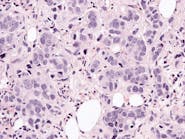Overall cancer death rates continued to decline among men, women, children, and adolescents and young adults in every major racial and ethnic group in the United States from 2015 to 2019, according to the latest Annual Report to the Nation on the Status of Cancer.
From 2014 to 2018, overall cancer incidence, or new cases of cancer, remained stable for men and children but increased for women and adolescents and young adults. This year’s report, published October 27, 2022, in Cancer, also highlights longer-term trends in pancreatic cancer, as well as racial and ethnic disparities in incidence and death rates for many individual cancer sites.
All of the findings in this report are based on data from before the COVID-19 pandemic.
The report shows that from 2015 to 2019, overall cancer death rates decreased by 2.1% per year in men and women combined. Among men, death rates decreased by 2.3% per year; among women, death rates decreased by 1.9% per year. The annual declines in death rate accelerated from 2001 to 2019 in both men and women.
The declines in death rates were steepest in lung cancer and melanoma (by 4% to 5% per year) among both men and women. Death rates increased for cancers of the pancreas, brain, and bones and joints among men, and for cancers of the pancreas and uterus among women.
The report showed that cancer incidence rates were relatively stable in men and women combined from 2014 to 2018. Among men, incidence rates remained stable during this period, but among women incidence rates rose by 0.2% per year.
Over the same time period, incidence rates increased for three of the 18 most common cancers among men: pancreas, kidney, and testis. Incidence rates in men remained stable for seven of the most common cancers and decreased for the remaining eight cancers. For women, incidence rates increased for seven of the 18 most common cancers: liver, melanoma, kidney, myeloma, pancreas, breast, and oral cavity and pharynx. Incidence rates among women remained stable for four of the most common cancers and decreased for the other seven cancers.
In men, the greatest incidence rate increase was seen in pancreatic cancer, which increased by 1.1% per year, and the steepest incidence rate decrease was seen in lung cancer, which fell by 2.6% per year. In women, melanoma had the steepest increase in incidence, rising by 1.8% per year, and thyroid cancer had the sharpest decrease, falling by 2.9% per year.
Overall cancer incidence rates during 2014 to 2018 were highest among non-Hispanic American Indian and Alaska Native (AI/AN) people, followed closely by non-Hispanic White people and non-Hispanic Black people. Overall cancer incidence rates were lowest among non-Hispanic Asian/Pacific Islander (API) and Hispanic people.
Incidence rates for all sites combined decreased among non-Hispanic Black, non-Hispanic API, and Hispanic men, but increased among non-Hispanic White, non-Hispanic API, non-Hispanic AI/AN, and Hispanic women from 2014 to 2018. Incidence rates were stable among non-Hispanic White and non-Hispanic AI/AN men and non-Hispanic Black women.
Among children younger than 15, overall cancer death rates decreased from 2015 to 2019, and incidence rates remained stable from 2014 to 2018. Overall cancer incidence rates were stable for non-Hispanic Black children over this period but increased for non-Hispanic White, non-Hispanic API, non-Hispanic AI/AN, and Hispanic children.
Among adolescents and young adults ages 15 to 39, overall cancer incidence rates increased by 0.9% per year from 2014 to 2018. The overall cancer death rate decreased by 3.0% per year from 2001 to 2005, but the decline slowed to 0.9% per year from 2005 to 2019.
The incidence of breast cancer, the most common cancer among adolescents and young adults, increased by an average of 1.0% per year from 2010 to 2018.
The researchers noted that racial and ethnic disparities exist for many individual cancer sites. For example, from 2014 to 2018, incidence rates for bladder cancer declined in non-Hispanic White, non-Hispanic Black, non-Hispanic API, and Hispanic men but increased among non-Hispanic AI/AN men. Incidence rates for uterine cancer increased among women of every racial and ethnic group from 2014 to 2018 except for non-Hispanic White women, who had stable rates.
From 2015 to 2019, prostate cancer death rates were stable among non-Hispanic White and non-Hispanic Black men but decreased among non-Hispanic API, non-Hispanic AI/AN, and Hispanic men. Colorectal cancer death rates were stable among non-Hispanic AI/AN men but decreased in men of all other racial and ethnic groups. Among women, death rates for lung, breast, and colorectal cancer decreased in nearly every racial and ethnic group. The exceptions were non-Hispanic API women, among whom breast cancer death rates remained stable, and non-Hispanic AI/AN women, among whom breast cancer death rates increased and colorectal cancer death rates remained stable.
This year’s report includes a special focus on trends in pancreatic cancer incidence, death, and survival rates. Although pancreatic cancer accounts for only 3% of new cancer diagnoses, it accounts for 8% of cancer deaths and is the fourth leading cause of cancer deaths in the United States for both men and women.





